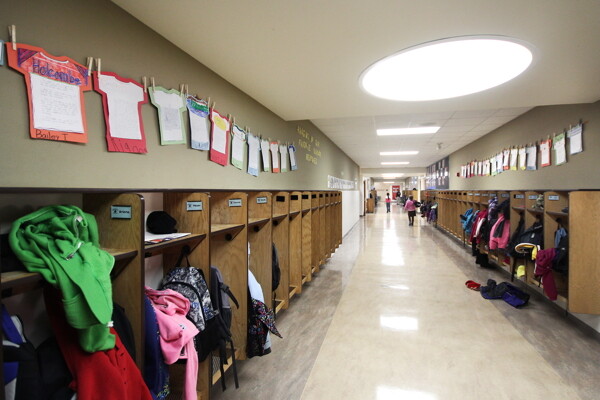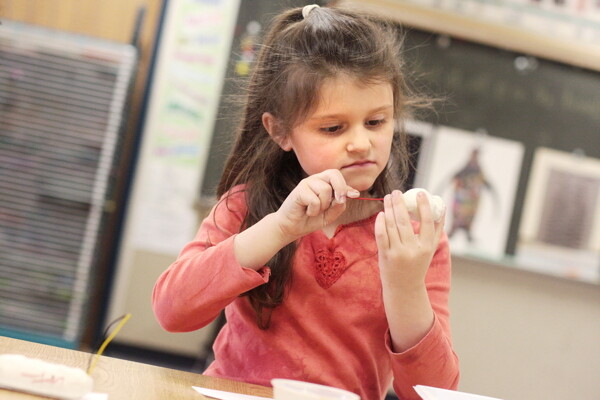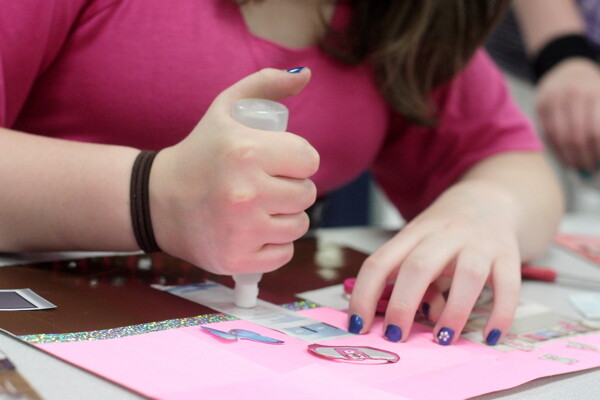Cautious Classrooms
a newly enforced safety code in schools aims to remove flammable material, but at what cost to creativity?
Kinzy Janssen, photos by Andrea Paulseth |

Classroom Combustion
What do exits, sprinklers, and a child’s self portrait have in common? From the perspective of a fire prevention officer, these are three factors that affect the safety of a building’s occupants in the event of a fire. Without adequate exits, students and teachers could be trapped by smoke and flames. Without sprinklers, fires could burn unattended for longer. And classrooms covered in combustible materials – from alphabet banners to periodic tables – raise the danger level by facilitating flame spread. Alongside a supposed safety boost, however, local teachers are wondering whether something else might be sacrificed.
In August, the Eau Claire Area School District sent an email notification to all teachers and administrators outlining the rules. Though enforced locally, these requirements were adopted from Wisconsin Safety & Professional Services fire prevention code SPS 314.01(9), which originated at the national level. (National Fire Prevention Association or NFPA).
The section that addresses specific teaching displays states that “only a maximum of 20% of any wall surface is allowed to be artwork, teaching materials or other combustible material.” In corridors, “only 10% of the wall area is allowed to be artwork, teaching materials or other combustible material.”
The section that addresses specific teaching displays states that “only a maximum of 20% of any wall surface is allowed to be artwork, teaching materials or other combustible material.” In corridors, “only 10% of the wall area is allowed to be artwork, teaching materials or other combustible material.”
First reactions were tinged with misunderstandings. After a frantic first few weeks, most teachers now know that cabinetry doesn’t count toward the percentage of combustible material, and that each separate wall can have 20% coverage. Though this demonstrates a milder policy than first thought, the changes are substantial.
“When I learned that this was not a new code, that it was just being ‘elevated in reinforcement,’ I guess I was pretty surprised about that,” said Kris Dimock, Director of Elementary Education for the ECASD. She mentioned that “coverage” rules had never been discussed before, even in an offhand sort of way.
According to SPS Public Information Officer Angie Hellenbrand, these limitations to the quantity of art, signage, and student work have been on the books since 2002. “All the school districts are required to comply with the code,” she said. “The state wasn’t aware it wasn’t being enforced in ECASD.”
As in past years, ECASD schools will undergo inspections twice annually, but this time Eau Claire Fire Department Lead Fire Inspector Mike Laska will be eyeing up surface area. Shortly after assuming the position in December of 2011, Laska said he was approached by a group of ECASD buildings and grounds workers, who recounted extreme cases where clutter was building up in closets and near exits. One even reported a project that involved a “truckload of driftwood” that was piled into the center of the classroom.
“You can’t put a whole bunch of combustible material in a classroom just hopingnothing happens,” said Laska.
In this way, fire prevention code treats fire in a paradoxical way: it is both preventable and inevitable. The section of code which views fire as inevitable tries to shape how flames flash through a building and how that could affect its occupants. Because a single sheet of paper burns more rapidly than a stack of paper, the code seeks to limit the amount of “single sheet” coverage in schools.
“The fire has got to stop somewhere,” said Laska.

the good intentions of the rules, but said we must be cautious as not to “destroy”
the learning environment.
Safety at the Expense of Learning
Presentation is at the core of a teacher’s daily efforts to make concepts more accessible. Perhaps that’s why classroom teachers are defending the functionality of those carefully-planned bulletin boards and math charts.. and why they bristle when their teaching materials are referred to as “combustible material.”
Todd Johnson, principal of Chippewa Valley Montessori, acknowledges that the rules were developed with good intentions, but says we must be cautious so as not to “destroy” the learning environment. “If you look at it as just something that could catch on fire... it’s not that clean,” he said. “We’re definitely looking at it through two different lenses, but I’m not sure how to cross that divide.”
Educators easily rattle off the ways in which visual materials directly affect a student’s interest in and comprehension of the lessons. South Middle School eighth grade U.S. History teacher Matthew Kulasiewicz says the visuals serve as a “hook,” or a conversation-starter.
The classroom environment helps them learn, feel good about their learning, and take risks in their learning... to be real honest, [not having examples of their work on the wall is] going to make learning more challenging for them. – Kris Dimock, Director of Elementary Education for the Eau Claire School District“There’s always something they’ll ask a question about that ties into our studies... [The new rules] take away that component from their learning... If there’s a blank spot on the wall, who’s talking about that?” he asked.
Johnson believes these limitations may not only stymie discussion, but achievement itself. “As more pressure is put on schools to raise the bar for achievement, we definitely need all the tools at our disposal,” he said. “If we need paper on the wall, then that can be considered a tool to enhance the educational processes taking place.”
Other educators talk about the value of posting student projects, stories, goals, and artwork. Dimock imagines a room in which these pieces of paper, viewed as latent fuel load for a fire, may not be displayed at all. “Number one, if they don’t see examples of their peers’ work, they might not have models to help them think differently,” she said. “Secondly, if they don’t have examples of their own work, this is a factor in social-emotional development. The classroom environment helps them learn, feel good about their learning, and take risks in their learning... to be real honest, it’s going to make learning more challenging for them.”
Bradley Johnson, Fire Prevention Section Chief for the state of Wisconsin, wonders whether proof of those benefits exists. “Do you have any documentation that I can review that demonstrates that limiting the amount of combustible materials on school room walls is a limitation on a students’ educational and creative opportunities?” he asks.
Todd Johnson rejects the notion that the classroom environment should be put to the test. “...There hasn’t been a need to do a study on that... it’s a practice that teachers use to enhance the educational process,” he said. ”I think there’s a problem when it’s phrased as a question such as that. We could ask, ‘what’s the difference in safety between 20 and 25%?’ But I don’t see anyone asking things like that.”
The educators and administrators I spoke with say there’s no question they are going to comply with the law. But they must also continue to provide effective visual tools that boost curiosity, concept-reinforcement, and self-confidence, while abandoning 80% of their wall space. This might take some trial and error.

Alternatives for a Stimulating Environment
Laska recognizes the give-and-take nature of safety versus stimuli, explaining that art classrooms and libraries, while “notorious” for paper content, should be allowed to preserve their functionality. “You have to enforce the code but still be true to what they are... art rooms,” he said. “Not that you’re looking the other way, but I want to be making it safer while at the same time not handcuffing you as an instructor.”
He says his children attend Colfax Elementary, where they’ve already been operating under the state fire code for several years now. Taking a page from their book, Laska recommends a system of rotation for student projects.
“I’ve walked through [Colfax Elementary], because my kids go there... and it’s way different. There’s a minimal amount of things hanging up whereas if you go through a school in the ECASD, it’s just plastered,” he said. “In the first grade and Kindergarten classrooms, roughly a four by five board – a corkboard with a wood frame – is used to rotate kids’ projects. When the turkeys are taken down, they put up the Santas or snowmen, so we’re getting the art projects at home.”
First grade teacher Tina Parker of Sam Davey Elementary said parents have already noticed the scaling back.
“Walking into the school – the hallways were always decorated with student work all over – parents have been saying it feels like the last days of school before summer vacation,” she said, going on to explain her new approach. “Two of my walls probably will be over that 20 percent, but I feel that everything I have in my classroom will benefit students. The younger students require such a print-rich environment... I have name plates on their table spots and now those also include color words, shapes, a number line. We usually display our goals so we can refer to them throughout the year... that will have to be changed as well. It will have to be more individualized, like in a folder.”
South Middle School students are already worried about how stripped-down walls may shape their learning experience. “Classrooms without stuff on the walls makes it feel cold and intimidating and not a very good learning environment,” said South Middle School eighth grader Skyler Chesnut. “Stuff on the walls makes it feel comfy, like you’re at home.” Fellow eighth grader Dane Sorenson sees practicality in things like “plagiarism rules and interesting quotes,” and wonders how a fire could spread so rapidly from paper-to-brick contact.
Laska suggests heightened use of technology to replace the versatility of printed paper. In his own home, he gets rid of books that he has finished reading so they don’t “pile up around the bookshelf” and serve as extra flammables. “Do I really need the book if I have to answer a student’s question? I can go online and find it quickly. All classrooms should be utilizing technology to their advantage... Teachers can use PowerPoint and be very creative.”

How Likely Is a Fire?
According to the NFPA, half of the fires that occur in buildings housing preschool through grade 12 are intentionally set – by children.
But how often does this happen locally? In almost ten years, the Eau Claire Fire Department has responded to 12 fires within the ECASD. Of those 12, only two of them were classified as “building” fires that happened where students actually have class. A fire that burned briefly at Menomonie High School last April was attributed to a heat lamp in one of the reptile cages, but started when children were not present within the building.
Still, fire prevention studies have been done that report facts such as, “A child can operate a lighter at age two.”
Eau Claire Fire Department Lead Fire Inspector Mike Laska believes the risk
for a destructive fire is higher than it was years ago. Part of the risk, he says, stems from the occupants of the building themselves – the kids.
Laska believes the risk for a destructive fire is higher than it was years ago. Part of the risk, he says, stems from the occupants of the building themselves – the kids.
“Kids these days have no outlet for their anger. When I was a kid, you’d go out and box each other... but now it’s ‘I’m gonna get you’ because of what’s on TV,” he said. “I personally feel there’s more chance of a fire today because they don’t know how to turn their anger into something better.”
According to Todd Johnson, that feeling isn’t concrete enough. “I would say schools are better than ever, safer than ever, what with recent initiatives such as PBIS, Positive Behavioral Interventions and Support... Schools are doing a better job than ever at recognizing when a child is struggling with their emotions.”
Once, in his nineteen years as an educator, Johnson says a fellow teacher at the middle level caught a student lighting a roll of toilet paper on fire and was able to stifle it. “When you know a child is struggling, you don’t leave that child alone, you monitor that child closely,” said Johnson.
Kulasiewicz, who has taught for 14 years, said he never felt threatened by the notion of a student starting a fire, and was not aware that the fire code seemed to incorporate the anger levels of children. “Did I think I was exposed to a fire hazard? That has not crossed my mind. [Fire officials] have the expertise on how fires are being started and whatnot... though I hadn’t been looking at it through an arson lens – certainly not.”
If the students themselves represent the threat of fire, it is ironic that they stand to suffer the most from a scaling back of combustibles.

Enforcement and Consequences
Fire inspections will continue to happen twice a year, but Laska acknowledges that change will take time because it’s targeted not just toward the physical environment, but to ingrained approaches.
“I can say to them, you can’t have stuff piled up around an exit and paperwork like this, and here’s what it does. They might say, ‘Oh, nobody ever told me that’ or ‘my room has been like this for thirty years’... this is why we’re talking about this,” he said.
If they’re not going to cooperate I have no choice but to fight them, way down there on that spectrum. They will have every opportunity to become compliant. This is why we’re offering a few suggestions. – ECPD Fire Inspector Mike Laska, on compliance with the new requirements
Long before a citation is written, teachers and administrators will have lots of chances to experiment with alternatives and learn the technicalities of the code.
“Educate, educate, educate – citing someone is that last resort. If they’re not going to cooperate I have no choice but to fight them, way down there on that spectrum. They will have every opportunity to become compliant. This is why we’re offering a few suggestions. With that said, it’s such a big hot topic that it might take one to two school years,” said Laska.
The citation along with a fine would be submitted to the owner of the building, which in this case would be the school district.
In addition to looking at buildings in terms of fire prevention, Laska unfortunately sees plenty of aftermath, of which he says “the loss and inconvenience is great.”
Experience has also taught him that there’s always a liability trail. “No fire will be treated as an accident by the media,” he said. If the fire department did not enforce the code, Mike Laska would be at fault. If the district did not come up with a plan for compliance, the district would be at fault. And if an individual instructor did not comply, the blame would be solely theirs.
Of the new rules, first grade teacher Parker doesn’t waste much time condemning them. She’s already looking for ways to adapt, and cares enough about the successful transition of her colleague’s classrooms to post her ideas in a blog (ecasdfirstgrademath.blogspot.com). She said her own pared-down room is sad, and that all she can do is hope that it doesn’t affect her students’ learning.
Smoke damage, structural damage, and water damage – all resulting from one spark – are instantly perceptible consequences. But education involves so many sparks, so many neural pathways being laid, happening constantly over so many years and under the instruction of so many teachers, that there is no easy liability trail. There’s no inspector to assess the damage. If regulations intend to benefit students bodily and actually harm them mentally, who would be to blame? And how far-reaching would the loss and inconvenience be?






















